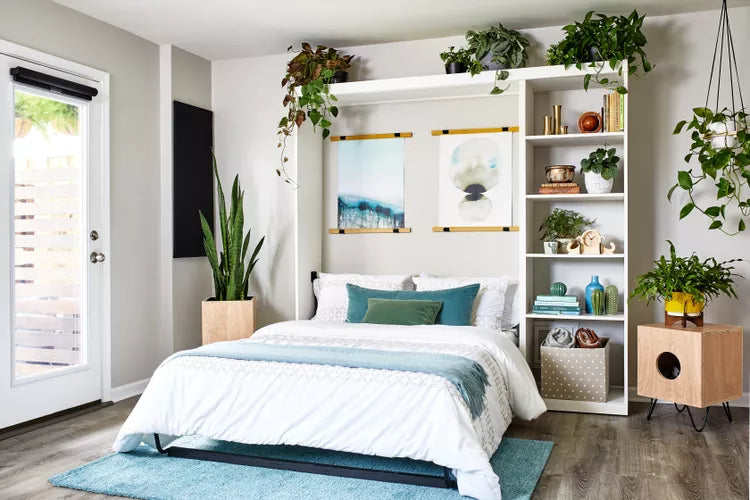Today's beds typically consist of a mattress on a supportive frame. In the U.S., most beds are single mattresses that range in thickness from 8-18 inches. Underneath the mattress sits a frame; each has different functionalities. For example, Murphy beds have a frame that folds into a wall, so usually they require thin mattresses. Meanwhile, a convertible sofa bed collapses into a couch, so it must be thin enough to fold, and a bunk bed has two, stacked beds connected by a ladder or staircase. In short, beds vary vastly in design and in size.
Here is a breakdown of typical bed sizes on the market and the most popular types of beds to choose from.
Bed Sizes
Bed sizes vary in length and width. The most common bed sizes and dimensions are as follows:
- California King: 72″ x 84″ (183 x 213 cms)
- King: 76″ x 80″ (193 x 203in cms)
- Queen: 60″ x 80″ (152.5 x 203 cms)
- Full: 54″ x 75″ (134.5 x 190.5 cms)
- Twin XL: 38″ x 80″ (96.5 x 203 cms)
- Twin: 38″ x 75″ in. (96.5 x 190.5 cms)
Bed Types
Canopy Bed

Throughout history, canopy beds have been used to create a dramatic focal point. They feature four posts at each corner to support a frame, and they are often draped in fabric. These kinds of beds are ideal for hanging mosquito netting to prevent nighttime bugs in tropical or coastal climates. Thicker canopies can act like blackout curtains to prolong and improve sleep. Contemporary canopy beds feature airy fabrics compared to the heavy-curtained versions of the past. This dreamy, tented bed style creates a private space within the bedroom.
Bunk Bed

This type of bed features one sturdy bed frame with two beds, one stacked above the other. Four poles or pillars at each corner of the bed provide support, and a ladder or stairs give access to the top bunk. The upper bunk also features a railing for safety. The main advantage of bunk beds is that they are space-efficient and ideal for small bedrooms. Usually, these beds are used for small kids sharing a room. A downside of bunk beds is that the ladders connecting the beds can present a hazard. It’s important to have secure guardrails and adequately sized steps to prevent any slips and falls.
Sleigh Bed
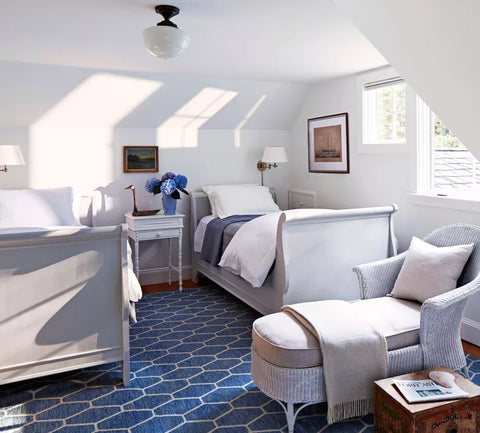
Sleigh beds curve outwards at the headboard and footboard to form an iconic silhouette. They are commonly made of polished wood, though sleigh beds come in various designs, including wooden, tufted, and styles that feature storage. Most sleigh beds with storage have drawers on the sides rather than the front.
Futon

A futon is a type of collapsible bed that can fold down into a bed or up into a sofa. Futons are multi-functional, serving different needs as required. Traditional Japanese futons date back to the 17th century, though these weren't exactly sofa beds so much as roll-away cotton mattresses. Today’s futons are ideal for compact spaces, cheaper than most beds, and ideal for temporary spaces. However, futons may not be comfortable or supportive enough to be a primary bed for long periods of time.
Murphy Bed
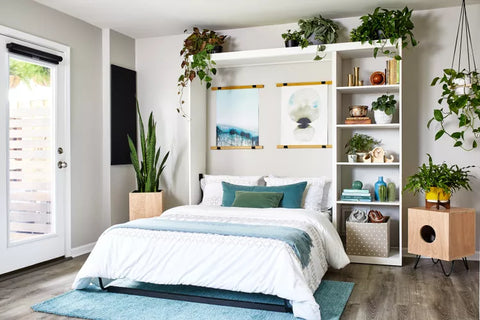
Also called wall beds or pull-down, fold-down, or hidden beds, Murphy beds are typically hinged on one side for vertical inset storage along a wall, closet, or cabinet. The bed draws its name from William Lawrence Murphy (1876–1959), who applied for his first patent for the design around 1900. Murphy beds are ideal for small spaces as they're designed to fold away seamlessly. One major con, however, is that they can be costly to customize and install because they have to be secured into the wall and often require hydraulics to improve ease of use.
Platform Bed
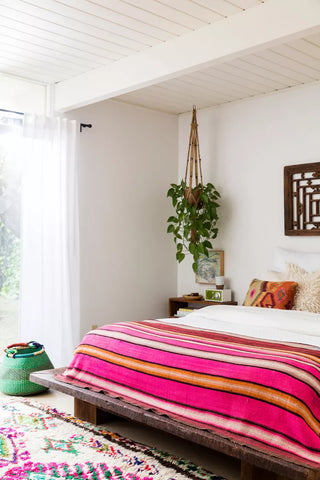
Platform beds are characterized by a sturdy solid surface that holds the mattress and a base. They do not require a mattress foundation or box spring. The main advantage of platform beds is their stability. They have a lower center of gravity because they are close to the ground, making them ideal for people who easily fall out of bed or who have trouble lifting their legs to get into a higher bed. Most platform beds also come with storage space underneath, increasing their functionality.
Trundle Bed
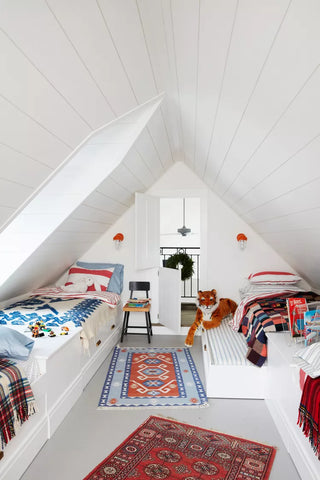
Ideal for small spaces, trundle beds feature a second mattress under the standard bed. This design provides extra space for sleepovers, guests, or co-sleeping. The second mattress has casters that make it easy to roll it out and return. The main drawback of trundle beds is that they tend to have weight limitations. They can't support as much weight as standard beds, but they are available in various sizes to suit any room.
Folding Bed

Folding beds, such as this option from Tina's Home - Walmart, offer fantastic space-saving benefits. They feature a metal frame and a folding mechanism. The frame is typically thin and lightweight, making it easy to move around. Hotels and hostels tend to have these on hand to add sleeping options for families with small kids or groups that need space for a guest. They fold vertically for storage, making them ideal for carting away when not in use.
Panel or Box-Spring Bed

Considered the most traditional type of bed, panel beds use wooden slats or metal rods as support panels under the mattress and mattress foundation. Some also have a side railing, footboard, and headboard. Because they need a mattress foundation or box spring to support the mattress, these beds tend to be heavier than other options. Also, if any of the supports fail, the mattress will eventually sag.
Daybed
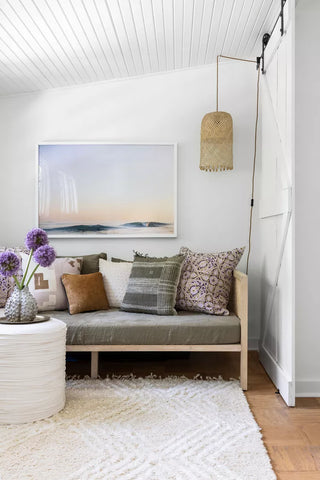
Daybeds are a hybrid of a couch, a chaise longue, and a bed, and double as seating and sleep space. Usually sized for a twin-size bed, the headboard tends to extend along the back of the daybed, similar to a sofa. Throw pillows and blankets can make a daybed look like an extra deep couch or be removed when it's time to create a cozy sleeping space.
Waterbed
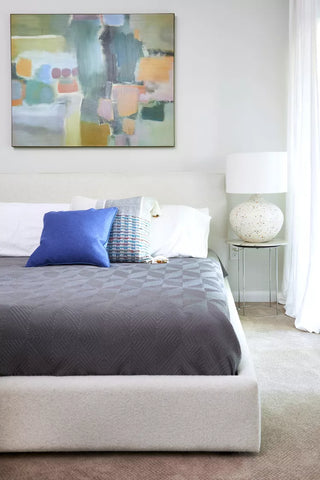
If you were around in the 1980s, chances are you probably slept on a waterbed at least once in your lifetime. A mattress filled with water seems like a good idea, especially to prevent bedsores and muscle aches, but for that same reason—a lack of back and leg support—water beds can be a poor fit for some people. Some water beds have heating mechanisms to add a soothing therapeutic effect and relieve the pressure on aching joints and muscles. These types of beds have largely gone out of style, especially as people realized the damage that can be caused by a leak.
Convertible Sofa Bed

Often confused for futons, convertible sofa beds look like traditional sofas but with a mattress folded inside. The mattress rests on a separate frame built under the couch. To convert the sofa to a bed, you just need to take off the sofa cushions and pull the mattress frame from under the sofa. Although the mattresses are still quite thin, these beds are typically more comfortable and supportive than a futon.
Airbed
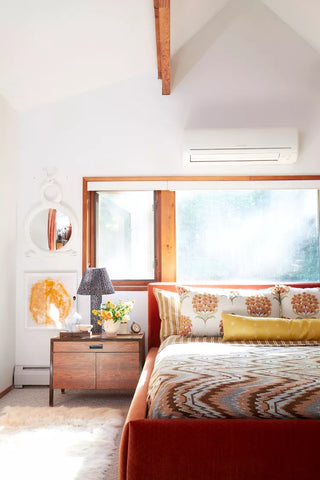
Easily confused with air mattresses, air beds are sturdier and designed to be high enough to be used at home for longer stints. Airbeds are easy to use, prevent pressure sores, promote back relaxation, save space, and are affordable. However, they have poor temperature control, can cause improper body alignment, and are at risk of a puncture.
Ottoman Bed

These bed frames are supported by hydraulics. The top, where the mattress rests, can be lifted up from the bed frame’s base to reveal storage that doesn’t take up any floor space. Ottoman beds are stylish and functional. Their major drawback is that they can be heavy, bulky, and expensive. It also usually requires multiple people to lift and reassemble when moving.
Loft Bed

Similar to a bunk bed, loft beds are raised off the ground. They consist of one or two beds and typically have a built-in desk, workstation, shelves, and/or chest of drawers below. They save floor space in a kid’s room, however, much like a bunk bed, loft beds pose a falling hazard, especially for small children and pets.
